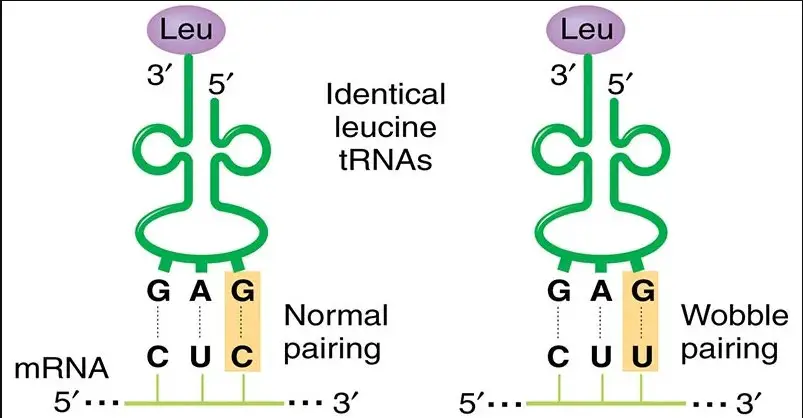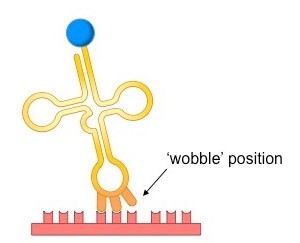The genetic code, a universal language of life, encapsulates the instructions for synthesizing proteins, the workhorses of the cell. Its deciphering was one of the monumental achievements of molecular biology, revealing how sequences of nucleotides encode amino acids. Two phenomena intrinsic to the genetic code, wobble and degeneracy, play pivotal roles in protein synthesis, each ensuring flexibility and efficiency in genetic translation.
Wobble and degeneracy are mechanisms that contribute to the genetic code’s robustness and versatility. The wobble hypothesis explains how tRNA molecules recognize more than one codon for an amino acid, allowing for a certain looseness in base pairing. On the other hand, degeneracy, or redundancy, refers to the phenomenon where multiple codons encode for the same amino acid, which is crucial for minimizing the effects of mutations on protein function.
These concepts are not merely academic; they have profound implications for understanding how genetic information is conserved and expressed in living organisms. Wobble and degeneracy ensure that the genetic code can be both specific and flexible, accommodating variations without compromising the integrity of the proteins produced. This balance between precision and versatility underpins the evolutionary success of diverse life forms, from the simplest bacteria to the most complex mammals.

Genetic Code Basics
Code Characteristics
The genetic code is the blueprint for life, a set of rules used by living cells to translate information encoded within genetic material (DNA or RNA) into proteins. Proteins, in turn, play a critical role in the structure, function, and regulation of the body’s tissues and organs. The genetic code is universal, degenerate, and unambiguous, characteristics that make it a fundamental aspect of life on Earth.
- Universal: The code is nearly the same across all organisms, from bacteria to humans. This universality suggests a common evolutionary origin and enables the transfer of genes between different species through genetic engineering.
- Degenerate: Multiple sequences of DNA (codons) can encode the same amino acid. This redundancy protects against mutations that might otherwise be harmful, a concept known as degeneracy.
- Unambiguous: Each codon specifies only one amino acid, ensuring accurate protein synthesis.
Role in Protein Synthesis
Protein synthesis is the process by which cells make proteins, which involves two main stages: transcription and translation.
- Transcription: The DNA’s code is transcribed into messenger RNA (mRNA), a single-stranded molecule that carries the genetic instructions from DNA in the nucleus to the ribosomes, the site of protein synthesis in the cell.
- Translation: The mRNA is translated into a specific amino acid sequence in a protein. The ribosome reads the sequence of mRNA three nucleotides at a time (each three-nucleotide sequence is called a codon), and each codon specifies a particular amino acid.
The role of the genetic code in protein synthesis is to ensure that the correct amino acids are added to the growing protein chain in the right order, facilitating the production of proteins necessary for life.
Wobble Phenomenon
Definition
The Wobble Hypothesis was introduced by Francis Crick in 1966 to explain the flexibility in the genetic code’s translation process. It refers to the fact that the pairing between the third base of a codon and the corresponding base of an anticodon on tRNA (transfer RNA) is not as strict as the other two bases, allowing for a “wobble” in the pairing.
Mechanism
The mechanism behind the wobble phenomenon allows a single tRNA to recognize multiple codons that code for the same amino acid. This is possible because of the flexible pairing at the third position of the codon, enabling one tRNA molecule to bind to codons with different nucleotides in this position.
- For example, in RNA, the base uracil (U) can pair with adenine (A) or guanine (G) in the third position of a codon, allowing one tRNA to recognize codons ending in A or G.
Examples
An example of the wobble phenomenon can be seen in the coding for the amino acid Valine. The codons GUU, GUC, GUA, and GUG all code for Valine, and due to the wobble base pairing, fewer tRNA molecules are needed to recognize these codons.
Degeneracy Concept
Explanation
Degeneracy in the genetic code refers to the concept that several different codons can encode the same amino acid. This characteristic of the genetic code is a crucial buffer against mutations in the DNA sequence.
Causes
The causes of degeneracy are rooted in the structure of the genetic code itself. With four different nucleotides available (A, U, G, C in RNA and A, T, G, C in DNA), there are 64 possible combinations or codons (4^3). However, there are only 20 standard amino acids, allowing multiple codons to specify the same amino acid.
Impact on Evolution
The degeneracy of the genetic code has significant implications for evolution. It allows organisms to tolerate mutations in their DNA, as many mutations, especially those in the third position of a codon, do not change the encoded amino acid, potentially resulting in no adverse effect on the protein’s function.
Wobble vs Degeneracy
Fundamental Differences
Wobble and degeneracy are related but distinct concepts. Wobble refers to the specific flexibility in base pairing between the codon and anticodon, particularly at the third position of the codon. In contrast, degeneracy refers to the broader phenomenon of multiple codons encoding the same amino acid.
Biological Significance
The biological significance of wobble and degeneracy lies in their contribution to the efficiency and accuracy of protein synthesis. Wobble allows for a reduced number of tRNA molecules to recognize all codons, while degeneracy provides a safeguard against mutations that could lead to harmful changes in protein structure and function.
Implications for Genetic Diversity
Both wobble and degeneracy have profound implications for genetic diversity. They allow for a variety of genetic sequences to encode the same proteins, supporting evolutionary flexibility and adaptability. This genetic flexibility enables species to explore new evolutionary paths without compromising the critical functions of their proteins.

Importance in Research
The fields of wobble and degeneracy within the genetic code have opened new avenues in scientific research, significantly impacting our approach to understanding life at a molecular level. These phenomena are not just footnotes in the study of genetics; they are central to our ability to innovate in medicine and biotechnology, offering insights that drive forward the boundaries of what’s possible.
Medical Advances
The understanding of wobble and degeneracy has led to significant medical advances, particularly in the development of new treatments and the improvement of diagnostic techniques. For instance:
- Targeted Gene Therapy: Knowledge of genetic code flexibility allows for the design of gene therapy strategies that can correct or compensate for mutations without affecting other parts of the genome, minimizing unintended effects.
- Personalized Medicine: By understanding the specific ways in which the genetic code can vary between individuals without altering protein function, researchers can tailor treatments to the genetic makeup of individual patients, improving efficacy and reducing side effects.
- Vaccine Development: Insights into genetic code redundancy have facilitated the development of vaccines that can target multiple strains of a virus, as seen in the flu vaccine, by focusing on conserved protein sequences that are less likely to mutate.
Biotechnological Applications
In biotechnology, the principles of wobble and degeneracy are applied to engineer organisms with novel capabilities, leading to breakthroughs such as:
- Improved Crop Varieties: Genetic engineering uses the principles of the genetic code to develop crops that are more resistant to pests, diseases, and environmental stresses, contributing to food security.
- Biopharmaceutical Production: The production of therapeutic proteins in microbial systems is optimized by modifying codon usage to match the host’s preference, a strategy made possible by our understanding of codon redundancy and tRNA pairing flexibility.
Evolutionary Perspective
The evolutionary implications of wobble and degeneracy are profound, shedding light on how life adapts and survives through genetic variation.
Adaptation and Survival
The genetic code’s flexibility, as evidenced by wobble and degeneracy, plays a critical role in the adaptation and survival of species. These mechanisms allow organisms to maintain protein functionality even as their DNA undergoes mutations, a crucial factor in evolving new traits and adapting to changing environments. For example:
- Environmental Adaptation: The ability of some organisms to thrive in extreme conditions, such as high temperatures or salinity, often hinges on subtle changes in protein structure that can be facilitated by the genetic code’s redundancy.
- Disease Resistance: In populations exposed to lethal diseases, genetic variability, including that provided by codon redundancy, can lead to the emergence of resistant individuals, ensuring the survival of the species.
Genetic Variation
Genetic variation is the raw material of evolution, and the wobble and degeneracy of the genetic code contribute to this diversity by allowing for multiple genetic sequences to encode the same protein. This redundancy means that mutations, especially silent mutations that do not change the amino acid sequence of proteins, can accumulate over generations without detrimental effects, providing a reservoir of genetic diversity that can be acted upon by natural selection. For instance:
- Evolution of New Functions: Sometimes, what starts as a silent mutation can, under the right circumstances, lead to the evolution of new protein functions, driving the diversification of life.
- Population Diversity: The genetic diversity within and between populations is critical for adaptation to new challenges, such as climate change or the emergence of new pathogens. The genetic code’s flexibility contributes to this diversity by allowing for variations that do not compromise protein function.
FAQs
What is the Wobble Hypothesis?
The wobble hypothesis posits that the anticodon of transfer RNA (tRNA), which pairs with the mRNA codon in protein synthesis, has a flexible pairing at the third nucleotide position. This flexibility allows a single tRNA to recognize and bind to multiple codons that code for the same amino acid, enhancing the efficiency of protein translation and reducing the need for numerous tRNA species.
How does Degeneracy contribute to genetic stability?
Degeneracy, or the redundancy of the genetic code, means that most amino acids are encoded by more than one codon. This redundancy contributes to genetic stability by making the code more tolerant to mutations. If a mutation changes one nucleotide in a codon, the altered codon might still encode the same amino acid, thanks to degeneracy, thus minimizing the impact of mutations on protein structure and function.
What are the implications of Wobble and Degeneracy for Evolution?
Wobble and degeneracy have significant implications for evolution, as they provide a mechanism for genetic variation while minimizing harmful mutations. This balance supports evolutionary adaptation by allowing organisms to explore genetic changes without jeopardizing essential functions, thus contributing to the diversity and adaptability of life.
Conclusion
Wobble and degeneracy, though seemingly esoteric aspects of molecular biology, are fundamental to the genetic code’s elegance and efficiency. They exemplify nature’s ingenuity in creating systems that are robust yet flexible enough to evolve and adapt. The interplay between these mechanisms ensures that life can thrive in the face of genetic mutations and environmental changes, highlighting the dynamic resilience encoded at the heart of living organisms.
The exploration of wobble and degeneracy not only enriches our understanding of genetic translation but also underscores the complexity and adaptability of life. These phenomena remind us of the sophistication inherent in biological systems, driving home the importance of molecular biology in deciphering the intricacies of life and evolution. Through such insights, we gain a deeper appreciation for the mechanisms that sustain life in all its forms, guiding both scientific inquiry and our understanding of the natural world.

